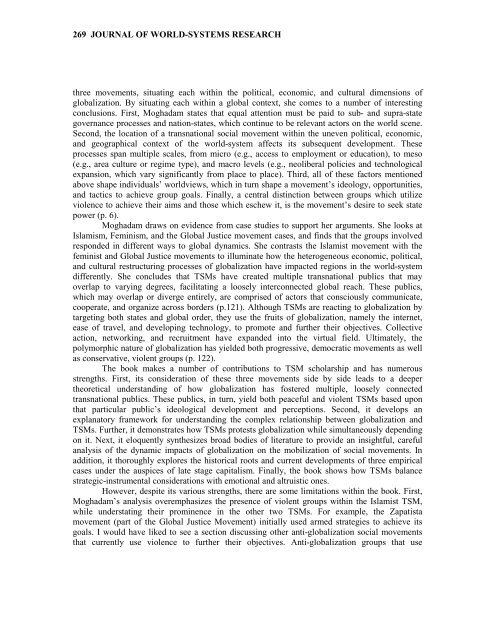Entire Volume 17 issue 1 - Journal of World-Systems Research ...
Entire Volume 17 issue 1 - Journal of World-Systems Research ...
Entire Volume 17 issue 1 - Journal of World-Systems Research ...
Create successful ePaper yourself
Turn your PDF publications into a flip-book with our unique Google optimized e-Paper software.
269 JOURNAL OF WORLD-SYSTEMS RESEARCH<br />
three movements, situating each within the political, economic, and cultural dimensions <strong>of</strong><br />
globalization. By situating each within a global context, she comes to a number <strong>of</strong> interesting<br />
conclusions. First, Moghadam states that equal attention must be paid to sub- and supra-state<br />
governance processes and nation-states, which continue to be relevant actors on the world scene.<br />
Second, the location <strong>of</strong> a transnational social movement within the uneven political, economic,<br />
and geographical context <strong>of</strong> the world-system affects its subsequent development. These<br />
processes span multiple scales, from micro (e.g., access to employment or education), to meso<br />
(e.g., area culture or regime type), and macro levels (e.g., neoliberal policies and technological<br />
expansion, which vary significantly from place to place). Third, all <strong>of</strong> these factors mentioned<br />
above shape individuals’ worldviews, which in turn shape a movement’s ideology, opportunities,<br />
and tactics to achieve group goals. Finally, a central distinction between groups which utilize<br />
violence to achieve their aims and those which eschew it, is the movement’s desire to seek state<br />
power (p. 6).<br />
Moghadam draws on evidence from case studies to support her arguments. She looks at<br />
Islamism, Feminism, and the Global Justice movement cases, and finds that the groups involved<br />
responded in different ways to global dynamics. She contrasts the Islamist movement with the<br />
feminist and Global Justice movements to illuminate how the heterogeneous economic, political,<br />
and cultural restructuring processes <strong>of</strong> globalization have impacted regions in the world-system<br />
differently. She concludes that TSMs have created multiple transnational publics that may<br />
overlap to varying degrees, facilitating a loosely interconnected global reach. These publics,<br />
which may overlap or diverge entirely, are comprised <strong>of</strong> actors that consciously communicate,<br />
cooperate, and organize across borders (p.121). Although TSMs are reacting to globalization by<br />
targeting both states and global order, they use the fruits <strong>of</strong> globalization, namely the internet,<br />
ease <strong>of</strong> travel, and developing technology, to promote and further their objectives. Collective<br />
action, networking, and recruitment have expanded into the virtual field. Ultimately, the<br />
polymorphic nature <strong>of</strong> globalization has yielded both progressive, democratic movements as well<br />
as conservative, violent groups (p. 122).<br />
The book makes a number <strong>of</strong> contributions to TSM scholarship and has numerous<br />
strengths. First, its consideration <strong>of</strong> these three movements side by side leads to a deeper<br />
theoretical understanding <strong>of</strong> how globalization has fostered multiple, loosely connected<br />
transnational publics. These publics, in turn, yield both peaceful and violent TSMs based upon<br />
that particular public’s ideological development and perceptions. Second, it develops an<br />
explanatory framework for understanding the complex relationship between globalization and<br />
TSMs. Further, it demonstrates how TSMs protests globalization while simultaneously depending<br />
on it. Next, it eloquently synthesizes broad bodies <strong>of</strong> literature to provide an insightful, careful<br />
analysis <strong>of</strong> the dynamic impacts <strong>of</strong> globalization on the mobilization <strong>of</strong> social movements. In<br />
addition, it thoroughly explores the historical roots and current developments <strong>of</strong> three empirical<br />
cases under the auspices <strong>of</strong> late stage capitalism. Finally, the book shows how TSMs balance<br />
strategic-instrumental considerations with emotional and altruistic ones.<br />
However, despite its various strengths, there are some limitations within the book. First,<br />
Moghadam’s analysis overemphasizes the presence <strong>of</strong> violent groups within the Islamist TSM,<br />
while understating their prominence in the other two TSMs. For example, the Zapatista<br />
movement (part <strong>of</strong> the Global Justice Movement) initially used armed strategies to achieve its<br />
goals. I would have liked to see a section discussing other anti-globalization social movements<br />
that currently use violence to further their objectives. Anti-globalization groups that use





